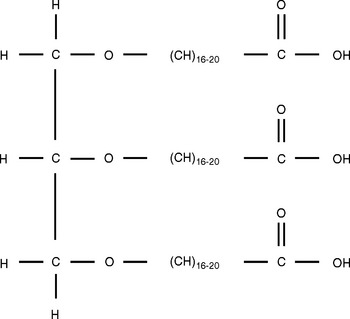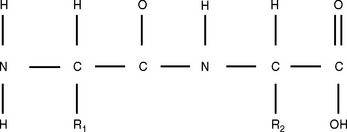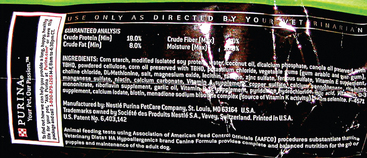1 Nutrition
Pregnant dogs do not need a change in diet for the first month after they have been bred. During that first month, the pups are developing but are not growing significantly. In the second month of pregnancy, the bitch needs an increase in calories. She can be fed either more of her regular food or a growth or performance food. I prefer the latter because many dogs have trouble eating a significant amount of food late in pregnancy, when their uterus is taking up much of the space in their abdomen. When you change diets, if you use diets from the same company and mix the foods, gradually increasing the amount of the higher-calorie food, you will be less likely to cause diarrhea.
I. BASIC NUTRITION
A. PHYSIOLOGY OF NUTRITION
What happens when an animal eats food? The food is broken down by the teeth and by enzymes in the saliva. Further physical breakdown of the food happens as it passes through the muscular activity of the stomach and into the intestinal tract. Other substances added to the food as it passes through the intestinal tract include acids, bicarbonate, bile, and water. By the time the digested food leaves the stomach and enters the small intestine, it is the consistency of watery mush. Enzymes are proteins secreted throughout the body that facilitate specific biological processes. In the mouth and intestinal tract, enzymes break down complex nutrients into smaller components that can then be absorbed through the intestinal wall directly into cells or into the bloodstream. Many of the nutrients absorbed into the bloodstream pass to the liver, where they are further processed. Any portion of the food that cannot be broken down into a usable nutrient passes into the large intestine, where it is excreted as feces. Some components of nutrients are passed into the urinary bladder and excreted as urine.
B. NUTRIENTS
2. Carbohydrates
Carbohydrates are a class of compounds made up of carbon, hydrogen, and oxygen (Figure 1-1). This class includes simple sugars and complex fiber. The body runs primarily on carbohydrates and is constantly making carbohydrates for fuel by gluconeogenesis and glycogenolysis. Because the animal’s body is capable of making carbohydrates and because carbohydrates are abundant in all types of food, no specific amount or type of carbohydrate is required in the diet.
3. Fats
Fats are complex compounds. The basic structure of any lipid or fat is the compound glycerol attached to three fatty acid chains (Figure 1-2). Fats provide a greater number of calories when they are broken down than do any other nutrients and often are used as a primary source of energy in diets. Fats are necessary for movement in the body of those substances that dissolve in fat, such as the fat-soluble vitamins A, D, E, and K, and for the formation of fatty substances that enhance body processes, such as development of the myelin sheaths that encircle brain cells.
4. Proteins
Proteins make up most body tissues and enzymes responsible for normal physiologic processes. Proteins are made up of amino acids; the order and arrangement of the amino acids are what give specific protein its properties (Figure 1-3). Amino acids are made up of carbon, hydrogen, oxygen, and nitrogen and may also contain sulfur, sugar (glycoprotein), or fat (lipoprotein).
5. Vitamins
Vitamin A is a fat-soluble vitamin intimately associated with vision. Vitamin A also contributes to normal bone development, production of spermatozoa (spermatogenesis), and fetal development. The parent compound, retinol, is derived from beta-carotene. It is an essential nutrient and is found in fish liver oils, animal liver, egg yolk, carrots, and dark green or yellow vegetables.
II. TYPES OF FOOD
A. COMMERCIAL
Commercial diets are those produced in bulk by pet food companies. Many varieties of diets are available, and no one diet is best for all dogs; dogs, like people, vary in how well they digest diets and in what they consider palatable. All commercially produced diets must be balanced and proven to contain the correct proportions of ingredients for the life stage for which they are marketed. A given food can be certified to be “complete and balanced” by the Association of American Feed Control Officials (AAFCO) in two ways. One is to submit a sample of the diet or its ingredients for analysis by a chemical laboratory, which can verify what compounds are present; however, this does nothing to prove palatability or digestibility of the diet. No diet can be considered complete and balanced if the dogs will not eat it or if some of the components bind with others, preventing their being digested and absorbed as expected. For this reason, the preferred method of certification is through feeding trials, in which the diet in question is fed to animals in the life stage for which its use is recommended and those animals are monitored to assess food intake and biological use of the diet. All commercial foods are labeled to document the content of the diet and contact information for the company; if you have any question about any diet, contact the manufacturer (Figure 1-4).
< div class='tao-gold-member'>
Stay updated, free articles. Join our Telegram channel

Full access? Get Clinical Tree






